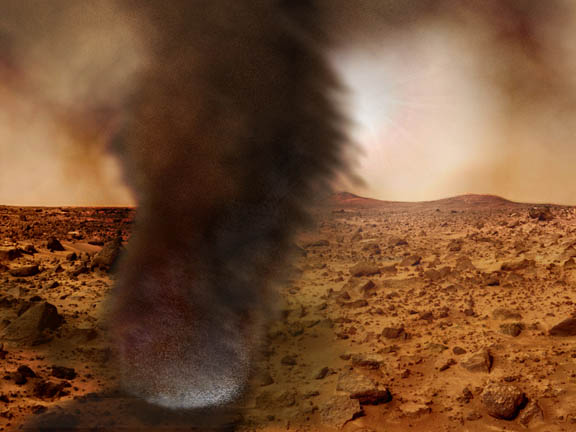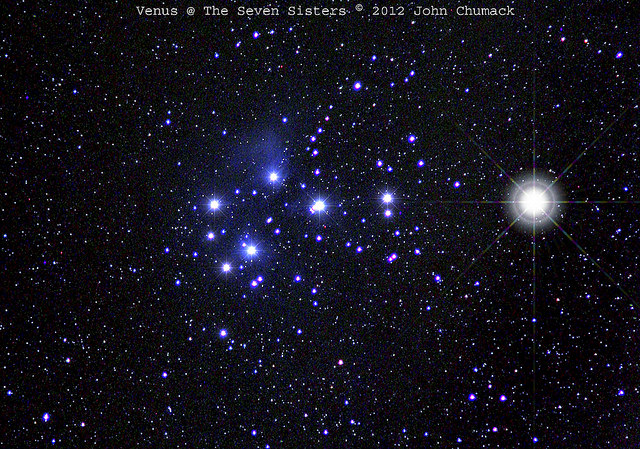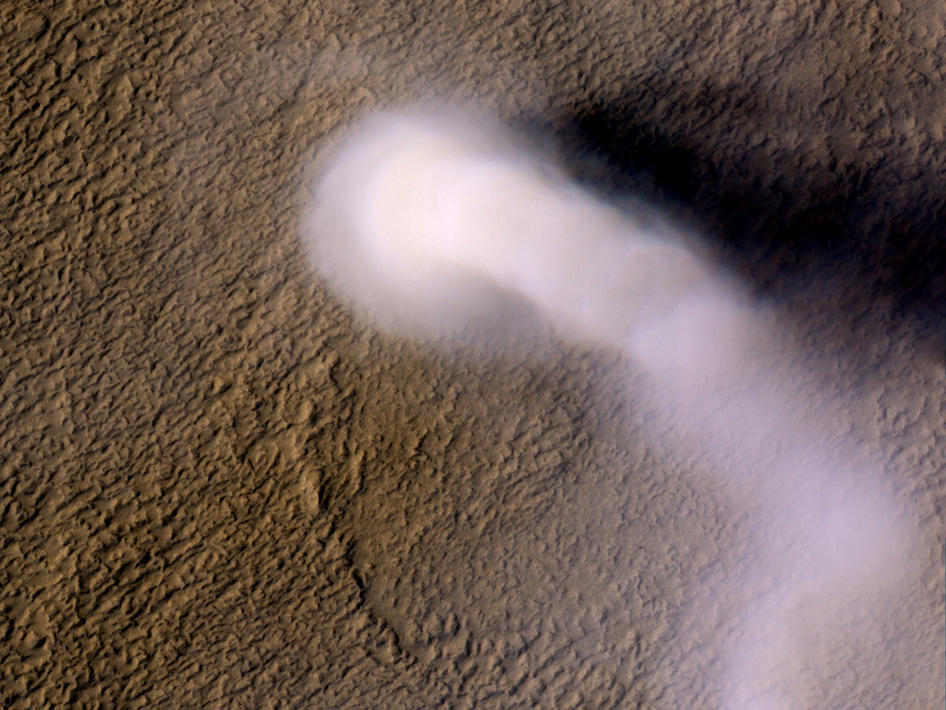Well, not really…… The Sun didn’t do a barrel roll; it was actually the Solar Dynamics Observatory that performed a 360-degree roll about the spacecraft-Sun line. But this video showing the change in perspective of SDO makes it appear as though the Sun suddenly shifted (that’s a new one for 2012 doomsdayers to go crazy over!) This roll maneuver wasn’t just so SDO could have a bit of fun, joyriding out there in its inclined geosynchronous orbit. The roll allows the scientists to remove the instrument optical distortions from the solar images taken by the Helioseismic and Magnetic Imager (HMI) to precisely determine the solar limb.
Continue reading “The Sun Does a Barrel Roll”
How Would Humans Respond to First Contact from an Alien World?
[/caption]
According to Star Trek lore, it is only 51 years until humans encounter their first contact with an alien species. In the movie “Star Trek: First Contact,” on April 5, 2063, Vulcans pay a visit to an Earth recovering from a war-torn period (see the movie clip below.) But will such a planet-wide, history-changing event ever really take place? If you are logical, like Spock and his Vulcan species, science points towards the inevitability of first contact. This is according to journalist Marc Kaufman, who is a science writer for the Washington Post and author of the book “First Contact: Scientific Breakthroughs in the Hunt for life Beyond Earth.” He writes that from humanity’s point of view, first contact would be a “harbinger of a new frontier in a dramatically changed cosmos.”
What are some of the arguments for and against the likelihood of first contact ever taking place and what would the implications be?
“One argument against first contact is from those who say there is no other life in the Universe,” said Kaufman, speaking to Universe Today via phone, “and with that is the Fermi paradox, which says that if there is so much life out there, why hasn’t it visited us yet? That was first posited back in the 1950’s and with everything we’ve learned since then, it seems rather presumptuous and Earth-centric to say that because no one has come to Earth, there is no life out there.”
Kaufman argues the Universe is so vast, the number of exoplanets is so huge – with the number of exoplanets in habitable zones now gaining in numbers almost daily – and we now understand that all the makings for the building blocks of life are out in space, so it defies logic to argue there is no other life out there.
Another argument against first contact states there might be microbial life elsewhere in the Universe, but it is not intelligent. “This is where the Fermi paradox comes in even more,” Kaufman said. “It certainly is true — as far as we know — that no intelligent life has made contact with Earth. But when you look at the amount of time we’ve been a technologically advanced society, it has only been a few hundred years. In the vastness of time, that is a pitifully small amount of time – truly nothing.”
In the immensity of cosmological time, Kaufman said, it is quite possible that microbial life emerged and evolved a billion years ago on another world and we missed coinciding with it, as civilizations could have come and gone.
“But all the makings are there and unless we want to say that Earth was made through divine creation or only through an unbelievable set of circumstances this is the only place in the Universe where life began, it just seems hugely, hugely implausible,” Kaufman said.
So, Kaufman says, the best, most logical argument is that life exists beyond Earth and in some instances includes what we would consider intelligence.
“If you have microbial life and billions of planets in habitable zones, the logic says that some of them will advance like we did,” Kaufman said. “There’s no reason to say that evolution is exclusive to Earth. It feels very 14th or 15th century-Earth-centric to say that we are the only place where there is intelligent life.”
Our continued scientific understanding, and in particular, the recent ongoing finding of so many exoplanets, has been a real revolution in our understanding of the cosmos, Kaufman said, and it is a huge boost to the logic of finding life elsewhere.
“It was hypothesized for decades, if not centuries that other planets were out there,” he said. “Now that we are finding planets almost every day, from a scientific perspective, it shows us that if the science is pointing in a certain direction, you just need to have the technology and the knowledge catch up to that hypothesis.”
Kaufman says that like the surge in finding exoplanets, astrobiology is likely the next area of science where breakthroughs will happen.
“Scientists almost unanimously believe there is other life out there, but we just don’t have the technology to find it yet,” he said. “Even with the recent potential cuts in NASA’s budget for planetary missions, and even if NASA is not able to send up as many missions, there is a broad movement going on in college campuses and institutes – from working on synthetic life, to studies in cosmology, and astrochemistry — all of those things are moving forward because there is a real sense that something is within reach. This area of science is just going to blossom.”
So if tomorrow (or on April 5, 2063) a spaceship shows up, how would we respond?
“On one level, I’d hope there would be a huge amount of wonder and awe and a recognition of the vastness of the Universe. But I also imagine there would be a lot of defensiveness, as well,” said Kaufman, referring to some, like Stephen Hawking, who say we shouldn’t send messages out into space — because if a more technically advanced civilization comes to Earth, the outcome for the less advanced (us) would likely be bad.
But Kaufman has hope that Earthlings would welcome a visit.
“Look at the continuing fascination of Roswell or UFOs,” he said. “Throughout history, humans have looked to the skies and thought that we’ve experienced something ‘out there’ – be it angels or gods or spaceships. There is, I believe, a deep human craving that we aren’t alone, and that would be a significant part of our response.”
For more information see Kaufman’s book, and website,”Habitable Zones”
NASA Jets Buzz The Capitol
[/caption]
Earlier today, Thursday, April 5, two NASA T-38 jets passed over the Washington, DC metropolitan area, during planned training and photographic flights. The photo above by Paul E. Alers shows the jets flying over the U.S. Capitol building.
See this and more images from the flyby on NASA HQ Photo’s Flickr page here.
Made by Northrop and powered by two afterburning General Electric J85 engines, a T-38 can fly supersonic up to Mach 1.6 and soar above 40,000 feet, about 10,000 feet higher than airliners typically cruise. The plane can wrench its pilots through more than seven Gs, or seven times the force of gravity.

“The T-38 is a great aircraft for what we need at NASA because it’s fast, it’s high-performance and it’s very simple,” says Terry Virts, who flew as the pilot of STS-130 aboard shuttle Endeavour. “It’s safe and it’s known. So compared to other airplanes, it’s definitely one of the best.”
Today the T-38 training jets flew approximately 1,500 feet above Washington between 9:30 and 11 a.m. EDT. The April 5 flights were intended to capture photographic imagery.
Check out a great article about NASA’s T-38s here.
Mars’ Giant Dust Devil in Motion
The folk at JPL have kindly put together an animation of the gigantic Martian dust devil spotted by the Mars Reconnaissance Orbiter. The dust devil is roughly 20 kilometers (12 miles) high, churning through the Amazonis Planitia region of northern Mars, and this shows what the tall but thin dust devil would look like if you were observing it as you hovered around in your Mars helicopter or balloon.
Could There Be Life In Them Thar Pits?

[/caption]
Recent images from ESA’s Mars Express spacecraft reveal long rows of crater-like depressions lining the flanks of ancient Martian volcanoes located in the planet’s vast Tharsis region. Rather than being the result of impact events, these “pit chains” were likely caused by underground lava flows — and could be a prime location for look for life.
Like similar features found on Earth, lava tubes on Mars are the result of rivers of magma that carved channels beneath the surface. When these channels empty out, a hollow tube is left. If the roof of a particularly large tube is near the surface the roof can eventually collapse, creating a surface depression… or, in some cases, opening up to the surface entirely.
Even though volcanism on Mars isn’t currently active — the last eruptions probably took place at least over a million years ago — the features left by volcanic activity are still very much present today and likely well-preserved beneath the Martian surface.
Shielded from harsh solar and cosmic radiation, the interior of such lava tubes could provide a safe haven for microbial life — especially if groundwater had found its way inside at some point.
Even though the surface of Mars can receive 250 times the radiation levels found on Earth, the layers of soil and rock surrounding the tubes can provide adequate protection for life, whether it be ancient Martian microbes or future explorers from Earth.
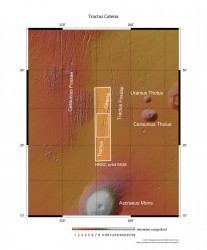
Of course, water and protection from radiation aren’t the only factors necessary for life. There also needs to be some source of heat. Fortunately, the pit chains imaged by Mars Express happen to be within one of the most volcano-laden areas of the Red Planet, a region called the Arcadia quadrangle. Within this area exist some of the largest volcanoes on Mars — and the Tractus Catena pits are located right in the middle of them.
If a heat source were ever to have been beneath the surface of Mars, there would be a good chance it would have been here.
And if our own planet is any measure of such things, where there’s heat and water there is often some form of life — however extreme the conditions may be.
“I’d like to see us land ON a volcano,” Dr. Tracy Gregg, a volcanologist with the University of Buffalo, had once told Universe Today back in 2004. “Right on the flanks. Often the best place to look for evidence of life on any planet is near volcanoes.”
“That may sound counterintuitive, but think about Yellowstone National Park , which really is nothing but a huge volcano,” Gregg elaborated. “Even when the weather in Wyoming is 20 below zero, all the geysers, which are fed by volcanic heat, are swarming with bacteria and all kinds of happy little things cruising around in the water. So, since we think that the necessary ingredients for life on Earth were water and heat, we are looking for the same things on Mars.”
As far as any remaining geothermal activity still happening beneath the Martian surface?
“I strongly suspect there are still molten (or at least mushy) magma bodies beneath the huge Tharsis volcanoes,” Gregg had said. (Read the full article here.)
On Earth, lava tubes, caves and underground spaces of all kinds harbor life, often specialized forms that are found no place else. Could this be (or have once been) the case on Mars as well? Only future exploration will tell. Until then, places like Tractus Catena will remain on scientists’ short list of places to look.
Read more on the ESA website here.
Astrophotos from Around the World of the Venus-Pleiades Conjunction
[/caption]
The past several evenings, Venus has been snuggling up to one of the most famous star clusters, the Pleiades. Universe Today readers have taken some beautiful images of that event, and they have generously shared them with us. Above is John Chumack’s stunning view from Ohio in the US; see below for more images from around the world!
The Pleiades, also known at the Seven Sisters, is a beautiful bright blue open star cluster 440 light years from Earth. Only once every eight years does this conjunction take place.
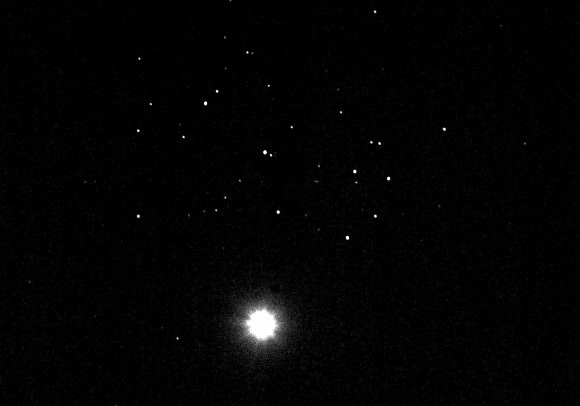
John Anton took this pretty image from New Jersey in the US. “It was a beautiful sight,” he said.
Astronomers say that the relative tightness of the cluster indicates this is a young group of stars, and the member stars were formed about 100 million years ago and will probably travel together through space as a bound cluster for another 250 million years before the gravity of the Milky Way breaks up the cluster into individual field stars.
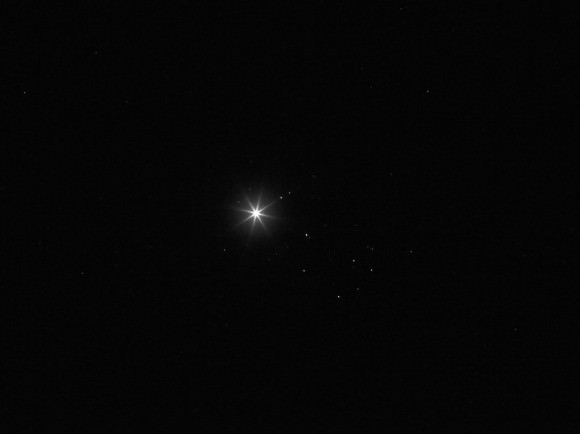
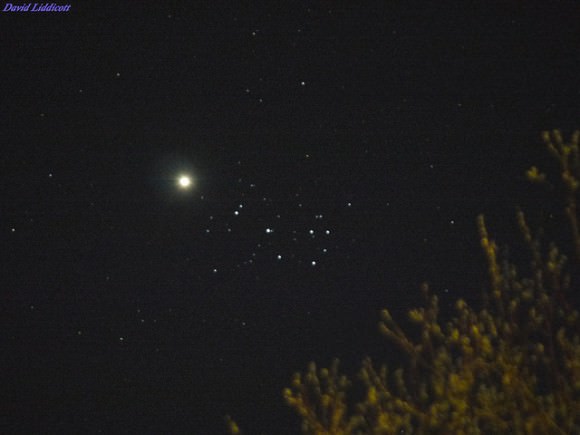
“An old SLR 70-210mm zoom lens on my DMC-G10. 5 second exposure, 1600 ISO. Tree illuminated partly by a neighbours light and partly by the built in flash on the camera,” says Dave Liddicott.
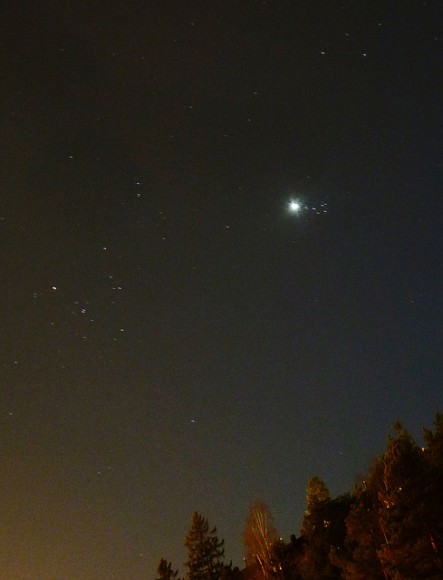
Sirrka Stephens from Norway took her image using a Panasonic Lumix DMC-F62, Leica 35mm, 30 sec., f/2.8, ISO 80, rotated to the left.
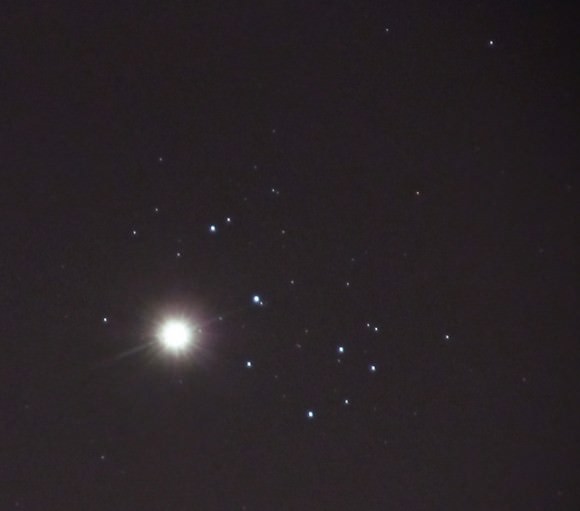
“Space Weed” from Beirut, Lebanon took this image on April 3, 2012. “2 second exposure, ISO 1600, f 5.9, Stack of 40 images and 18 dark frames, Level correction in Photoshop,” Space Weed reports.
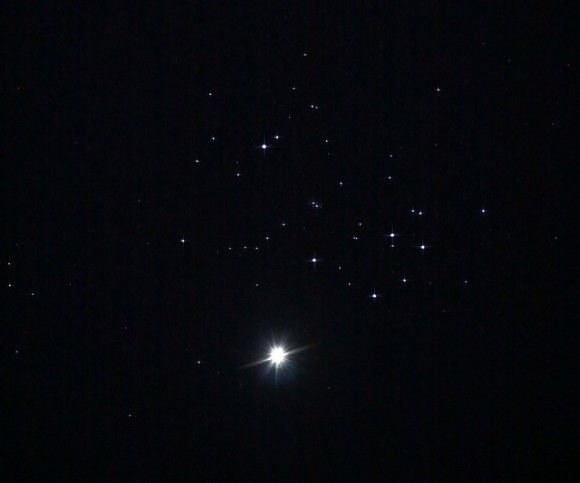
Tavi Greiner on the east coast of the US took this lovely image on April 2, 2012.
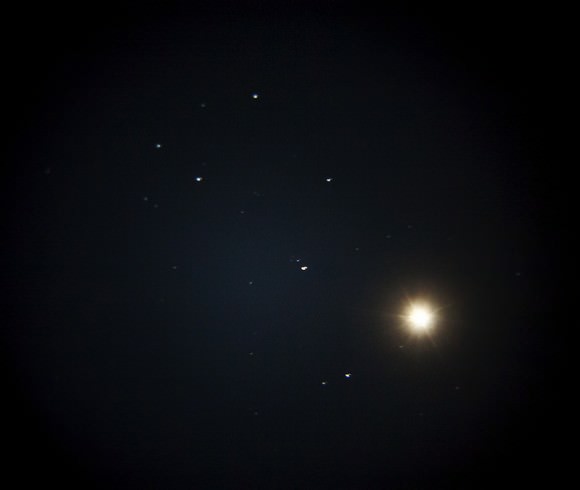
Another beautiful view from Austin Russie. “A luminous Venus passes directly between Earth and an elusive cluster of stars known as the Pleiades,” he says.

Laurent Laveder from France sent in this unusual image showing the shifting of Venus in the Pleiades in two hours’ time.
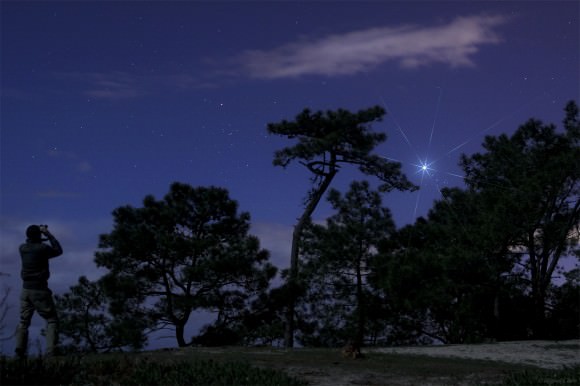
The final image is by Miguel Claro from Portugal, who can be seen enjoying the stars with binoculars “in a peaceful moment,” he said.
There are more images on UT’s Flick page, so check them out!
Want to get your astrophoto featured on Universe Today? Join our Flickr group, post in our Forum or send us your images by email (this means you’re giving us permission to post them). Please explain what’s in the picture, when you took it, the equipment you used, etc.
Editor’s note: Apologies for the irregular formatting of this article — we’re working to fix it!
Polar Telescope Casts New Light On Dark Energy And Neutrino Mass
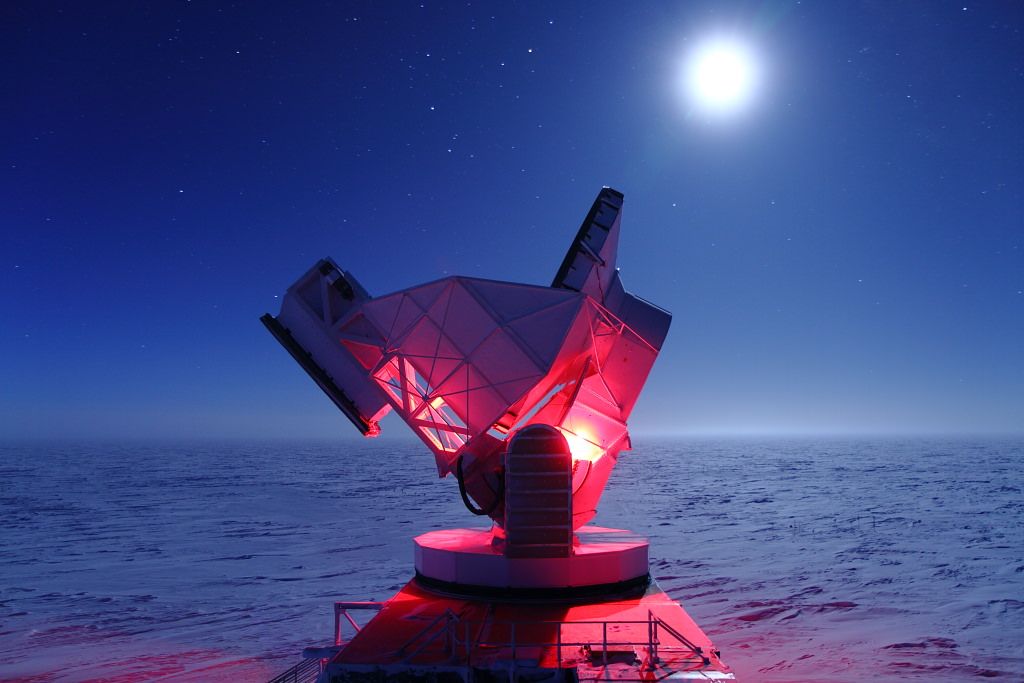
[/caption]
Located at the southermost point on Earth, the 280-ton, 10-meter-wide South Pole Telescope has helped astronomers unravel the nature of dark energy and zero in on the actual mass of neutrinos — elusive subatomic particles that pervade the Universe and, until very recently, were thought to be entirely without measureable mass.
The NSF-funded South Pole Telescope (SPT) is specifically designed to study the secrets of dark energy, the force that purportedly drives the incessant (and apparently still accelerating) expansion of the Universe. Its millimeter-wave observation abilities allow scientists to study the Cosmic Microwave Background (CMB) which pervades the night sky with the 14-billion-year-old echo of the Big Bang.
Overlaid upon the imprint of the CMB are the silhouettes of distant galaxy clusters — some of the most massive structures to form within the Universe. By locating these clusters and mapping their movements with the SPT, researchers can see how dark energy — and neutrinos — interact with them.
“Neutrinos are amongst the most abundant particles in the universe,” said Bradford Benson, an experimental cosmologist at the University of Chicago’s Kavli Institute for Cosmological Physics. “About one trillion neutrinos pass through us each second, though you would hardly notice them because they rarely interact with ‘normal’ matter.”
If neutrinos were particularly massive, they would have an effect on the large-scale galaxy clusters observed with the SPT. If they had no mass, there would be no effect.
The SPT collaboration team’s results, however, fall somewhere in between.
Even though only 100 of the 500 clusters identified so far have been surveyed, the team has been able to place a reasonably reliable preliminary upper limit on the mass of neutrinos — again, particles that had once been assumed to have no mass.
Previous tests have also assigned a lower limit to the mass of neutrinos, thus narrowing the anticipated mass of the subatomic particles to between 0.05 – 0.28 eV (electron volts). Once the SPT survey is completed, the team expects to have an even more confident result of the particles’ masses.
“With the full SPT data set we will be able to place extremely tight constraints on dark energy and possibly determine the mass of the neutrinos,” said Benson.
“We should be very close to the level of accuracy needed to detect the neutrino masses,” he noted later in an email to Universe Today.
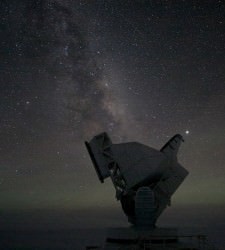
Such precise measurements would not have been possible without the South Pole Telescope, which has the ability due to its unique location to observe a dark sky for very long periods of time. Antarctica also offers SPT a stable atmosphere, as well as very low levels of water vapor that might otherwise absorb faint millimeter-wavelength signals.
“The South Pole Telescope has proven to be a crown jewel of astrophysical research carried out by NSF in the Antarctic,” said Vladimir Papitashvili, Antarctic Astrophysics and Geospace Sciences program director at NSF’s Office of Polar Programs. “It has produced about two dozen peer-reviewed science publications since the telescope received its ‘first light’ on Feb. 17, 2007. SPT is a very focused, well-managed and amazing project.”
The team’s findings were presented by Bradford Benson at the American Physical Society meeting in Atlanta on April 1.
New Image Shows Beautiful Violence in Centaurus A
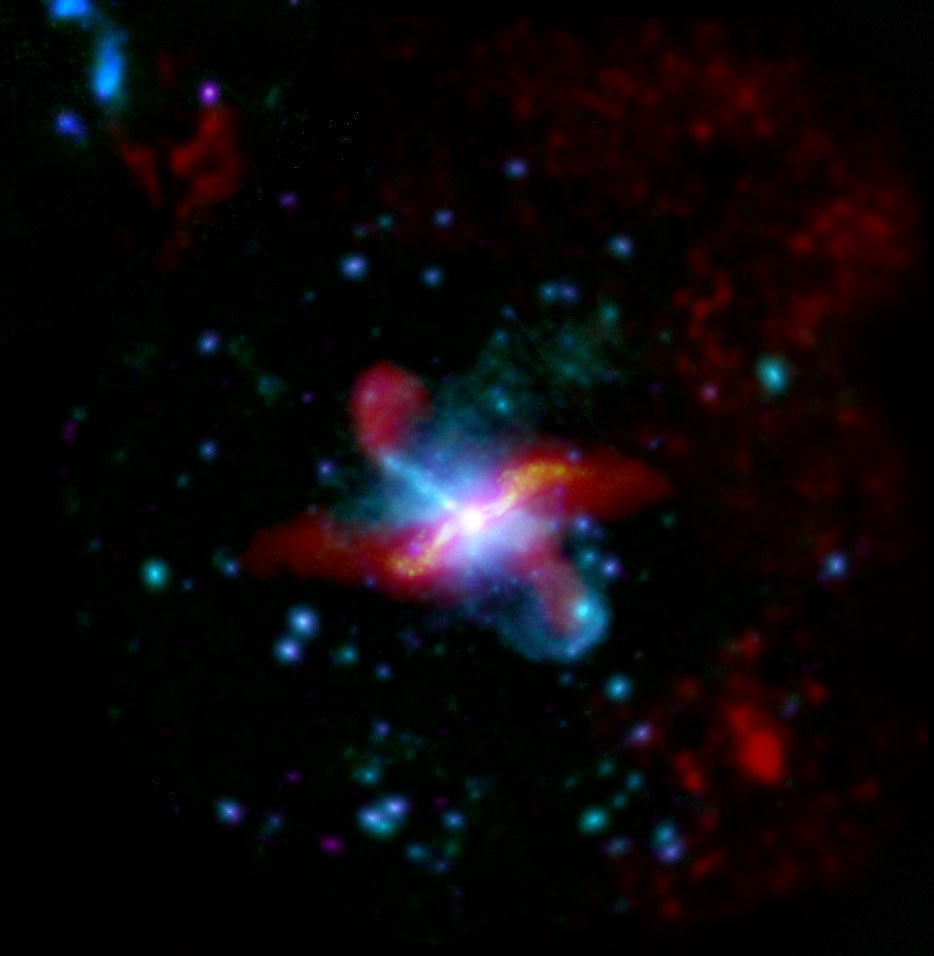
[/caption]
The mysterious galaxy Centaurus A is a great place to study the extreme processes that occur near super-massive black holes, scientists say, and this beautiful new image from the combined forces of the Herschel Space Observatory and the XMM-Newton x-ray satellite reveals energetic processes going on deep in the galaxy’s core. This beautiful image tells a tale of past violence that occurred here.
The twisted disc of dust near the galaxy’s heart shows strong evidence that Centaurus A underwent a cosmic collision with another galaxy in the distant past. The colliding galaxy was ripped apart to form the warped disc, and the formation of young stars heats the dust to cause the infrared glow.
This multi-wavelength view of Centaurus A shows two massive jets of material streaming from a immense black hole in the center. When observed by radio telescopes, the jets stretch for up to a million light years, though the Herschel and XMM-Newton results focus on the inner regions.
At a distance of around 12 million light years from Earth, Centaurus A is the closest large elliptical galaxy to our own Milky Way.
“Centaurus A is the closest example of a galaxy to us with massive jets from its central black hole,” said Christine Wilson of McMaster University, Canada, who is leading the study of Centaurus A with Herschel. “Observations with Herschel, XMM-Newton and telescopes at many other wavelengths allow us to study their effects on the galaxy and its surroundings.”
Find more information on this image at ESA’s website.
New Gigantic Tornado Spotted on Mars
[/caption]
Last month, we were excited to share an image of a twister on Mars that lofted a twisting column of dust more than 800 meters (about a half a mile) high. We now know that’s nothin’ — just peanuts, chump change, hardly worth noticing. The Mars Reconnaissance Orbiter has now spotted a gigantic Martian dust devil roughly 20 kilometers (12 miles) high, churning through the Amazonis Planitia region of northern Mars. The HiRISE camera (High Resolution Imaging Science Experiment) captured the event on March 14, 2012. Scientists say that despite its height, the plume is just 70 meters (70 yards) wide.
Yikes! After seeing trucks thrown about by the tornadoes in Dallas yesterday, it makes you wonder how the MER rovers and even the Curiosity rover would fare in an encounter with a 20-km high twister.
The image was taken during late northern spring, two weeks short of the northern summer solstice, a time when the ground in the northern mid-latitudes is being heated most strongly by the sun.
Dust devils are spinning columns of air, made visible by the dust they pull off the ground. Unlike a tornado, a dust devil typically forms on a clear day when the ground is heated by the sun, warming the air just above the ground. As heated air near the surface rises quickly through a small pocket of cooler air above it, the air may begin to rotate, if conditions are just right.
Obviously, conditions were more than just right to create such a whopper.
Source: JPL
Timelapse: A Tribute to Sky Gazers
If you’ve fallen for the enchantment of a night out watching the stars, you’ll relate to and revere in this new timelapse video.
“This timelapse production is a tribute to all skygazers around the world who enjoy exploring the night sky with their telescopes,” said Babak Tafreshi, an astronomer, journalist and director of The World at Night (TWAN). “I’m happy to release this in April 2012 in celebration of the Global Astronomy Month, an international program of Astronomers Without Borders in partnership with world-wide astronomy centers and clubs.”
Continue reading “Timelapse: A Tribute to Sky Gazers”



